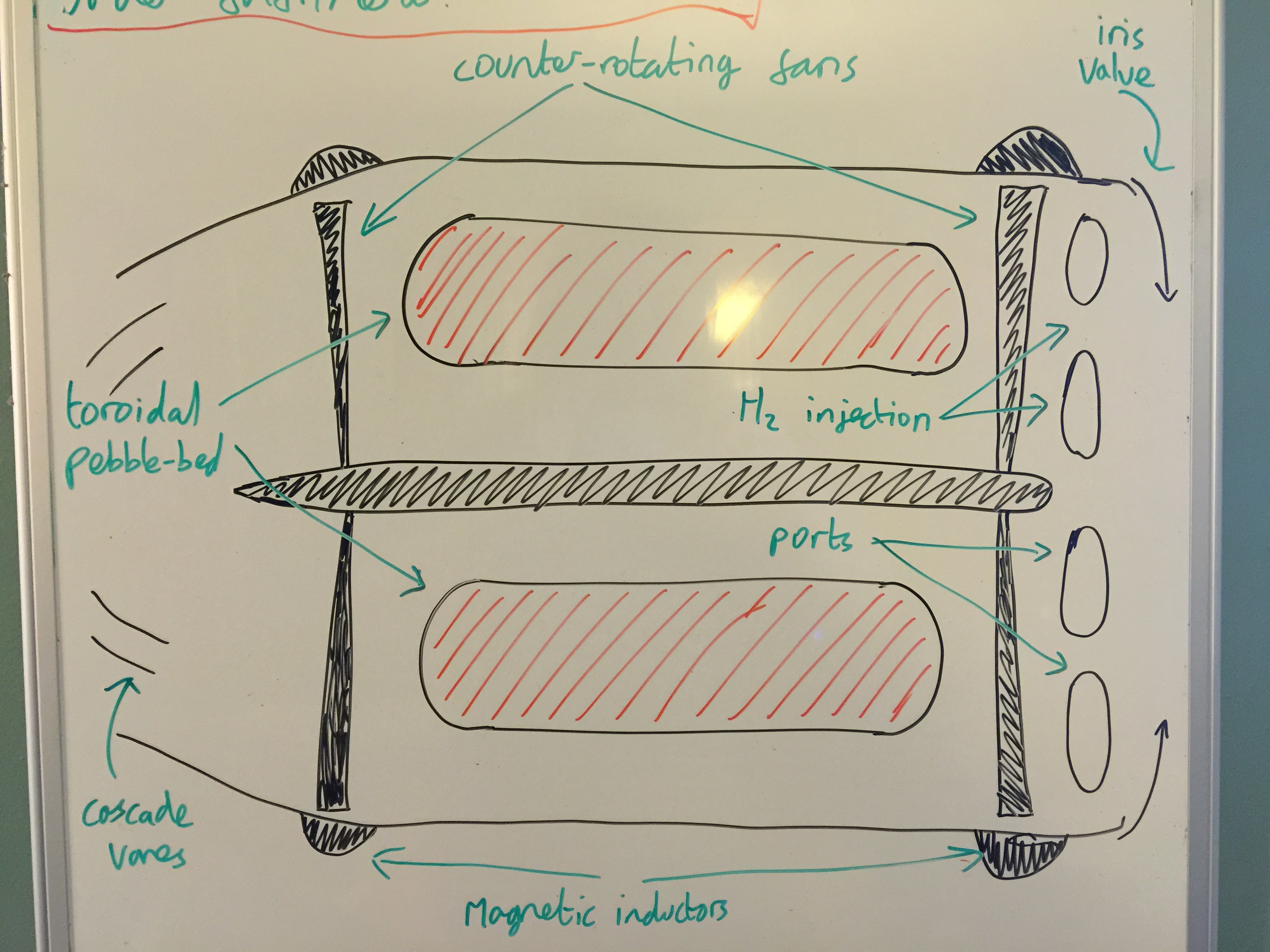Well, folks, it’s terrible sketch day again here at the Eldraeverse…

So, this is my approximate representation of what exactly one of those “trimodal NTRs” I keep talking about as the engine of choice for shuttles, lighters, and suchlike planetarily-landing craft looks like in cross-section. It is anything but a complete engineering diagram, especially inasmuch as the profile of the engine looks roughly cylindrical here, which of course it isn’t, especially on the inside; in actuality, it requires some pretty fancy variform properties in order to seamlessly switch internal profiles between those suited for a ducted-fan, for a ramjet, for a scramjet, and for a rocket – it being intended as a design that will function in all flight modes from the ground up to orbit – but I can’t properly represent those.
But it should give one an idea of what the major components are, with the possible exception of the cooling systems.
The core of the engine is the toroidal pebble-bed fission reactor that provides its power.
In its first mode, intended for low altitude, low speed flight modes, the reactor runs at low power, and while it does dump its waste heat into the airstream, it’s not used for thermal power. Instead, it generates electricity which is fed to the magnetic inductors, which in turn rotate the counter-rotating fans at each end of the engine. In this mode, the whole thing acts as a simple ducted-fan (usually a tilt-fan, for maneuverability).
In its second mode, once it’s got up to sufficient speed to make ram compression work, the flight control system feathers and locks the fans, shifts internal profile, and turns the reactor up to high (thermal) power. It then becomes a nuclear-thermal ramjet (yes, just like Project Pluto, although with better shielding), and the cascade vanes come into play for thrust vectoring. Once you’re going fast enough, continued internal profile shifts let it function as a nuclear-thermal scramjet, too.
And finally, once you start running out of atmosphere, the flight control system commands the iris valve to seal off the intake entirely, and the injection ports to open and squirt good old liquid hydrogen in there in place of the ram air, at which point it’s switched from being a nuclear-thermal ramjet to a nuclear-thermal rocket, suitable for use in circularizing at apoapsis and making your orbital rendezvous.
When you plan on landing planetside again, you run through the same three modes in essentially the opposite direction, with some pauses for aerobraking in between.
(Side note: it wasn’t actually intended at the time of design, but it seems to me that this also makes a pretty good representation of what’s inside those engine pods you see on the side of your Firefly-class transport ship…
…Jetfire Technologies, ICC, warns that kicking anyone’s henchman into your engine intake will void the warranty.)

Pingback: Lowari-class pinnace/shuttle | The Eldraeverse
Technically, the “nuclear-thermal scramjet” mode isn’t a scramjet. See, the ‘sc’ in ‘scramjet’ stands for the thing that makes scramjets difficult, namely ‘supersonic combustion’. And since there’s no combusting internal to this engine, both the term and the related problems are inapplicable.
Perhaps an appropriate moniker would be “Supersonic heating ramjet”, or just “full-supersonic flow ramjet”; but those don’t abbreviate quite so pronouncably.
Eh, the problems of supersonic heating (to the point of thermal plasmification) and its necessary profile changes are close enough for translated nomenclaturical work, especially since no-one wants to call such a device a “shamjet”.
Implications unfortunate.